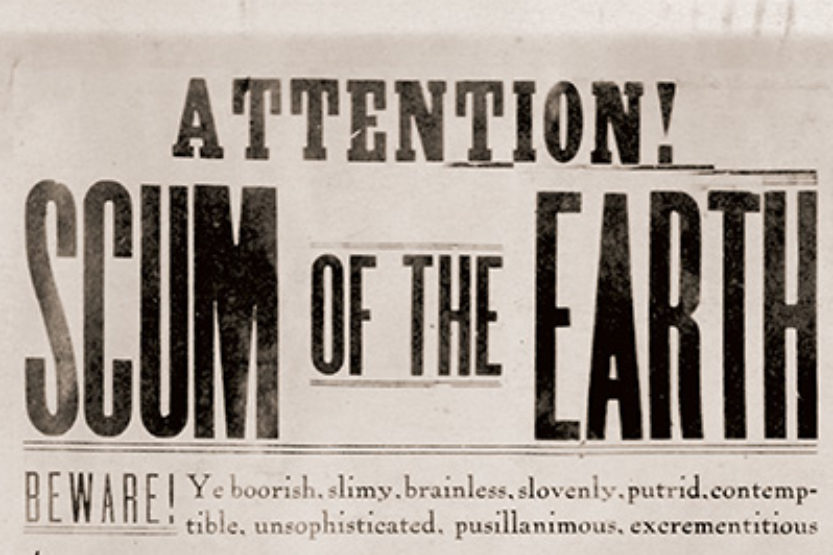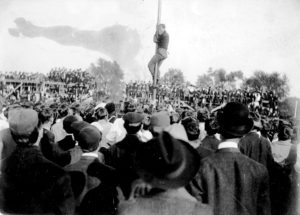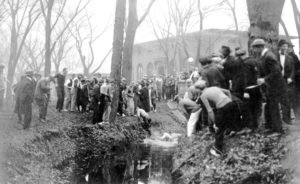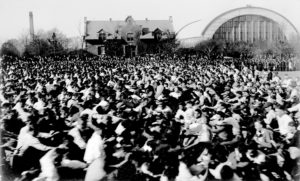Battle of the classes
 Upperclassmen created posters filled with insults aimed at freshmen. (Photo courtesy of UI Alumni Archives)
Upperclassmen created posters filled with insults aimed at freshmen. (Photo courtesy of UI Alumni Archives) You knew a freshman when you saw one. A sophomore and a junior, too.
Long before the University of Illinois selected orange and blue as its official colors in 1894, each class boasted its own set of colors—a tradition rooted in the school’s early years that endured until the 1930s. Incoming freshmen inherited colors from the class that had graduated the previous spring. The four different color combinations were red and blue, cardinal and gray, blue and white, and purple and champagne. The class of 1908’s sweater, for example, sported cardinal and gray.
Simple color combinations weren’t the only distinguishing feature among classes. Senior males were allowed to wear both class colors on their caps, while juniors could don only one. Sophomores, by comparison, weren’t permitted to wear a class color on headgear of any kind. Pity the poor freshmen, who were required to wear green beanies, making them easy marks for mischief and hazing.
Fighting Illini
As the colors—even the beanies—suggest, class unity was a powerful phenomenon during the University’s early years, sparking fierce rivalries between upper and lower classmen. During the 19th century and early decades of the 20th, competition between classes frequently spiraled out of control, with students getting injured during tugs-of-war, other competitions or out-and-out fights. In fact, it would be fair to assert that class fights emerged as one of the more prominent social activities on campus.

Color Rush featured two greased poles displaying the class colors. Students were divided, with one group tasked with guarding the base of the pole and the other with mounting the opposing pole and tearing down the class colors. (Photo courtesy of UI Alumni Archives)
The role of class color figured into one particularly popular—and potentially dangerous—competition known as Color Rush, an event involving freshmen and sophomores that extended from 1891 to 1908. An account published in The Daily Illini, the school’s student newspaper, described it this way: “Two poles, greased and bearing the class colors at the top, were planted about 60 feet apart. Equal numbers of freshmen and sophomores guarded the poles, which bore their colors, while two other groups, equally divided, sought to tear down the colors.”
Color Rush frequently culminated in injuries and suspensions, prompting its retirement and the introduction of freshmen-sophomore Push Ball contests as a replacement.
Push Ball placed two teams of 11 players on a 140-yard-long, 50-yard-wide field, the objective being to propel a 50-pound, 6-foot-diameter ball toward opposing goals consisting of two 18-foot-high posts positioned 20 feet apart and connected by a 7-foot-high crossbar. Pushing the ball under the bar scored five points, and lifting or throwing it over the bar scored eight. In a show of civility, the game was divided into halves with an intermission in between.
However, the game proved extremely dangerous, with injuries all but assured. Although Push Ball figured into the University’s first Homecoming celebration in 1910, the school replaced it with Sack Rush, a new competition, in 1913.
Sack Rush lined freshmen and sophomores across from each other on a playing field, with a succession of canvas sacks lining the field’s middle. At the firing of a gun, classes would streak toward the sacks to gather as many as possible. Although it sounds wholesome, the competition simply served as a springboard for the classes to engage in brawls.
And a word or two between upperclassmen and the lowly freshmen wasn’t limited to the playing field. Some of the more creative types among the upper ranks penned insulting broadsides, as seen on page 52.
Up a creek
Many male upperclassmen turned those words into action, requiring freshmen to wear their tell-tale green beanies. Freshmen in public without their beanies placed squarely on their heads were subject to punishment by upperclassmen. The most common of which was being dunked in Boneyard Creek, a fifth-ridden sewer that also proved convenient for hazing.

Freshmen who failed to wear their green beanies squarely placed on their heads could find themselves dunked in Boneyard Creek. (Photo courtesy of UI Alumni Archives)
In 1901, an especially brutal wave of hazing swept campus, and in one incident, a freshman was dunked in Boneyard Creek twice in one night. The ritual was easy to execute. Under the cloak of night, upperclassmen invaded a freshman’s room, seized and carried him to Boneyard and threw him in—turning evening’s darkest hours into a “time of terror.” The ritual was so ingrained in campus life that one student cheer went, “Boneyard! High-Dive! Hey-Rube! Ought Five!” They also sketched cartoons, such as the one shown to the right from the 1905 Illio yearbook. Its caption reads: “Friday—Sept. 18.—Generally speaking, the Boneyard was considerably dammed by Freshmen this night.”
Not surprisingly, freshmen were happy to divest themselves of their beanies at the conclusion of the school year, to the extent that a new tradition, cap burning, commenced in 1914 and occurred off and on until the beginning of the Great Depression. Participants made a show of tossing their caps into a blooming bonfire on Illinois Field, the home of Illini athletics. So ended their period as punching bags and their transition from tormented to tormentor.
By then, they’d been well-schooled in it.


